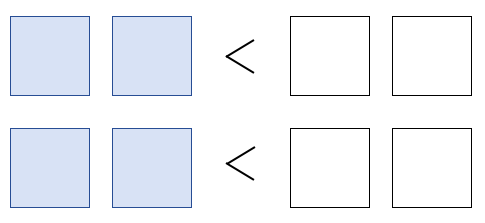Or search by topic
Number and algebra
Geometry and measure
Probability and statistics
Working mathematically
For younger learners
Advanced mathematics
Less Is More



- Problem
- Getting Started
- Student Solutions
- Teachers' Resources
Less Is More
This is a game for two people, but is better played in two teams of two.
You will need a 1-6 or 0-9 dice. The interactivity here can be used to simulate throwing different dice.
Each team should draw some cells that look like the picture below. (The cells on the left don't need to be a different colour, but we will refer to those cells later.) Alternatively, you could print off this sheet of cells.

Version 1
You will need to throw the dice eight times in total. After each throw of the dice, each team decides which of their cells to place that number in.
When all the cells are full, each team will have created four two-digit numbers.
Teams then check if their number sentences are correct:
- If both number sentences are correct, the team scores the sum of the two two-digit numbers written in the blue boxes.
- If only the first number sentence is correct, the team scores the two-digit number in the top blue boxes.
- If only the second number sentence is correct, the team scores the two-digit number in the bottom blue boxes.
The winner is the team with higher score. See the hint for some examples of scoring.
Have a go at playing the game and keep a running total of your scores.
- Who is the winner after ten rounds?
- Who is the first to reach 500 points?
In between rounds, teams might like to find the highest possible score they could have achieved, if they had known the eight numbers in advance. These scores can be added to their running totals.
Will this affect your strategy in the next round?
Version 2
Now, imagine that the numbers 1, 2, 3, 4, 5, 6, 7 and 8 have been thrown.
Where would you place them in order to get the highest possible score?
Can you provide a convincing argument that you have arranged the numbers in the best possible way?
Have a go at playing the game just as you did in Version 1, but this time note down all eight dice rolls before deciding where to place them.
You can score in the same way as you did in Version 1. This time it could be the first to reach 1000 points who wins!
An interesting follow-up to this game is More Less is More, which again challenges you to create correct statements, but this time after carrying out some simple calculations.
Why play this game?
This game is thought-provoking and very engaging. It encourages discussion of place value, alongside valuable strategic mathematical thinking, and it helps learners become more familiar with the mathematical symbols for 'greater than' and 'less than'.
Setting up the game with students working collaboratively with a partner offers the chance for them to focus on all five key ingredients that characterise successful mathematicians.
Possible approach
Before the interactivity was added, this problem featured in an NRICH Primary and Secondary webinar in November 2022.
You can introduce the game by playing the video, or recreating the video contents for yourself using the interactivity.
Invite students to have a go at the game in pairs, ideally using the interactivity on a computer or tablet. Set them the challenge to try to find the highest possible scores in fewer than three attempts.
Once they have had chance to play several rounds, bring everyone together to discuss their thinking. How are they deciding where to place the numbers? How are they trying to maximise their score?
Having shared strategies, students might enjoy playing in teams of two against each other. Who can reach 500 points first? Or who can make the highest score after five rounds?
The first challenge of More Less is More (called 'sum-sum') is a natural extension to this task.
Key questions
How are you trying to make sure each number sentence is true, while still managing to get a high score?
How are you deciding which cells to fill in first?
Possible extension
An interesting follow-up to this game is More Less is More, which again challenges learners to create correct statements, but this time after carrying out some simple calculations.
Possible support
Learners could try a single-digit version of the game initially, rolling the dice four times.
Learners could be provided with number cards that they can move around the grid to consider different options.

